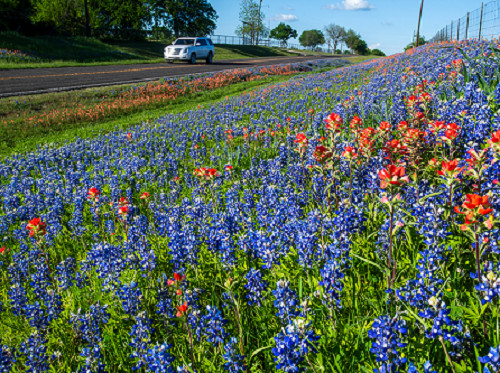Across the country, state departments of transportation are investing in a variety of landscaping projects to help transportation infrastructure become more “eco-supportive” of native habitats.
[Above photo by TxDOT]
For example, since mid-2023, a team of landscape architects from the Washington State Department of Transportation has worked with the University of Washington’s Botanic Gardens and Seattle Parks to select and plant native flora and create habitats for wildlife on Foster Island – an area that previously served as a construction zone for the 520 bridge project.
In a blog post, WSDOT noted that its work crews spent the last year moving topsoil, boulders, and trees into the former bridge construction zone – as well building irrigation systems and crushed rock paths to mark trails for park visitors.
Those crews are now planting native ferns and Oregon grape plus evergreen, dogwood, and willow trees – among other flora – that will be monitored for the next three years to ensure they thrive.
Crews placed habitat logs in the landscape to provide homes for insects that birds and small mammals will feed on; logs that also provide a great home for frogs and salamanders. The logs serve a long-term purpose, too, WSDOT noted, providing nutrients as they decay and creating fertile new ground for more plants to grow.
Meanwhile, the Texas Department of Transportation is gearing up to support wildflower season along roadways statewide.
The agency has been planting and maintaining wildflowers on highway right of way since the mid-1930s and TxDOT Vegetation Specialist Travis Jez said the agency’s wildflower program works not just in springtime, but throughout the year.
“Our overall objective is to have a regenerative side of the road that takes care of itself and is able to maintain itself,” Jez noted in a statement.
More than 5,000 species of wildflowers and native grasses decorate Texas roadsides. While part of their benefit is for beautification, they’re also important pollinator plants. Monarch butterflies rely on the wildflowers during their migrations, as do 900 other species of butterflies, bees, birds and various creatures, the agency said.
To ensure the habitats are available for the ecosystems they support, TxDOT has a delayed mowing schedule during certain times of the year to let the plants grow strong and tall.
Delayed mowing not only helps the environment, but it also is a cost-effective move that allows TxDOT to focus labor force and funding on other projects for a couple of months, the agency said.
When TxDOT does mow the fields, the agency said that helps disperse seeds into the ground to sprout up the next season. In addition, it helps clear any debris covering the soil to allow for the seeds to make better contact. Depending on the need for more wildflowers in a certain area, TxDOT said it will plant up to 30,000 pounds of seeds each year.
And in Tennessee, a new $3 million-plus state DOT landscaping project will seek to beautify a long stretch of highway in the Chattanooga area.
The Tennessee Department of Transportation said the U.S. 27 landscaping project – awarded to Stansell Electric Company – will include the planting of trees, shrubs, prairie grasses, wildflowers, and a variety of other ground cover crops as well as the installation of an irrigation system.
“This landscaping project is the first of its kind, and we’re delighted it’s been let to construction,” noted Daniel Oliver, Tennessee DOT’s Region 2 assistant chief engineer, in a statement.
Work on this landscaping project is scheduled to begin in mid-2024 and should be wrapped up by December 2025.
“Our partnership with the Tennessee Interstate Conservancy has played a critical role in the advancement of this project,” Oliver added. “Upon completion, the project will beautify an important corridor in the Chattanooga area and enhance the natural scenic beauty of the Tennessee landscape.”

